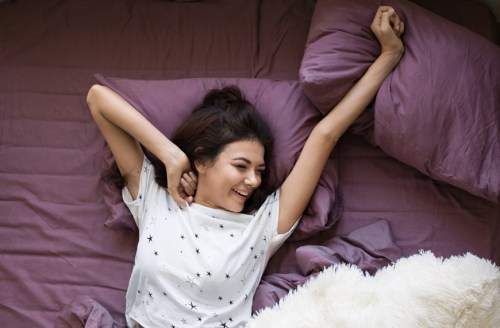Our editors independently select these products. Making a purchase through our links may earn Well+Good a commission
4 common myths about how to get the best sleep ever, debunked
It's a widely held belief that getting the best night of sleep involves eight consecutive hours of shut-eye, but one sleep expert and author, Nick Littlehales, has a different take. He suggests sleeping in 90-minute cycles, that don't need to happen in one lump some. Rather, take advantage of naps.

Sleep is a health-boosting basic human need that can help you keep your nutrition goals in check, stay mentally healthy, and fight the onset of Alzheimer’s disease. But sometimes even despite your most earnest efforts to have the best night of rest ever—like consciously eating well and exercising regularly—you’re left tossing and turning. Well, have you ever considered that you’re going about it all wrong? Maybe that magical eight-hour block of sleep shouldn’t be the dream you’re chasing.
Mentally, the brain uses sleep as “recovery” time to process and store information—which is why your mental clarity and agility suffer when you’re sleep-deprived, according to Nick Littlehales, elite sleep coach and author of Sleep: The Myth of 8 Hours, the Power of Naps and the New Plan to Recharge Your Body & Mind. But, he adds, there are many misconceptions about sleep and maximizing its efficacy, the biggest being that folks need to clock in eight hours of it in a row.
Rather, he contends, different people need different amounts of sleep based on their activity levels and individual biology—and not all during a single, nighttime snooze. Other good news? Pre-bed Netflix might not be killing your dreams, and your mattress doesn’t have to cost a zillion dollars for it to afford you a night of restful sleep. And that’s just the tip of this dreamy, myth-busting iceberg.
Check out the 4 common sleep myths one expert wants to bust.
Myth 1: The nightly goal should be 8 hours of consecutive sleep
Ever laid awake, riddled with stress about how with every passing minute and—shudder—hour, you’re only going to be more tired the following day? (Same.) Well due to a number of REM-disrupting reasons (maybe something you ate before bedtime is keeping you up, or the temperature in your room isn’t optimal), getting to sleep is only half the battle of banking eight consecutive hours of shut-eye.
To deflate that stress, Littlehales suggests sleeping in a series of 90-minute cycles. Under clinical-trial conditions, this has shown to be the amount of time required to complete one full cycle through the stages of sleep. But, how you clock in the number of daily cycles you need in order to function best is up to you and your schedule.
Say you fall asleep at 11 p.m. and naturally wake up at 12:30 a.m.—Littlehales says not to fight it. Get out of bed, walk around your house—really, do whatever you want—and then get back into bed and do it again. Still stressed about how this works? Keep in mind that naps (or controlled recovery periods, as Littlehales call them) during the day or early evening count toward your shut-eye quota, too.

Myth 2: You need to fall asleep during “nap” time
Controlled recovery periods (AKA the naps that many busy folks swear by to power through their day) are a chance for your body and mind to take a load off. Don’t have time to fall asleep during the workday? NBD, since Littlehales says you don’t even need to fall asleep in order to reap the mind-focusing benefits naps can offer; simply resting, or meditating, during a recovery period provides the same results.
“Maybe you can find 30 minutes on your evening commute where you can secure your belongings, close your eyes and allow your mind to wander,” suggests Littlehales, who also points to lunch breaks as an opportunity to take a brain nap. Even if you end up with some “homework” as a result of your mental break, Littlehales contends that you’ll be more likely to “arrive home more refreshed and better able to enjoy your evening—even if your evening consists of getting more work done.”
Myth 3: The more expensive your mattress, the better you’ll sleep
Littlehales refers to beds as “sleep kits” in part dispel the notion that you need an expensive mattress to sleep well. “A good sleep kit could consist of a piece of foam on the floor and some non-allergenic, breathable sheets,” he says.
And in a perfect world (one that Marie Kondo would no doubt approve), your “sleep kit” would be the only thing in your recovery room: “You want your body and mind to associate this place with rest—not with anything else. Definitely nothing stimulating,” he explains. That means your WFH desk belongs in another room, and your wall art shouldn’t conjure any emotional response from you. So consider keeping your chic statement wallpaper in a different area of your Zen den.

Myth 4: Netflix in bed is the kiss of dozing death
Looking at screens right before bed and just as you wake up could have a negative impact on your recovery, but if you’re unable to chill without first watching Netflix don’t freak out. “When you realize that you have control over your recovery periods—that you don’t have to do all of it in one block overnight—you regain freedom over your schedules and your health,” explains Littlehales.
Even if it means you won’t get the number of 90-minute sleep cycles you’d prefer on a given night, if scrolling your feeds for a bit or catching up on your latest binge-watching obsession will help you decompress, go for it. Littlehales suggests that you use a full 90-minute cycle in this case to relax and then get into bed. The next day, through controlled recovery periods, an earlier bedtime or both, aim to catch up. “The key is to wake at the same time every morning, even on the weekends—our bodies need that anchor,” he says.
Good news: These high-tech (and cute!) pajamas might help you improve your sleep game. And here are all the other ways technology might come to your bedroom this year.
Sign Up for Our Daily Newsletter
Get all the latest in wellness, trends, food, fitness, beauty, and more delivered right to your inbox.
Got it, you've been added to our email list.










